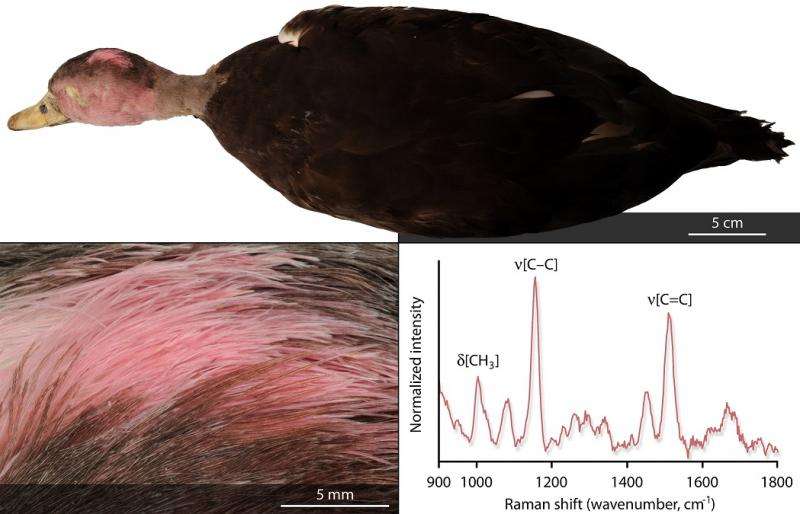Extinct pink-headed duck derived its unique color from carotenoids

The exotic Pink-headed Duck (Rhodonessa caryophyllacea), whose rose-colored plumage set it apart from any other species of waterfowl, was last seen in the wild in India in 1949. Scientists never discovered what pigment was responsible for its unique and vivid coloration—until now. A forthcoming study in The Auk: Ornithological Advances confirms that carotenoids, pigments that provide the bright colors of birds such as cardinals and flamingos but are much rarer among gamebirds, were responsible for the namesake trait of the extinct Pink-headed Duck.
The only place carotenoids had previously been found in the feathers of a duck was in the tiny "ear" spots of Australia's Pink-eared Duck (Malacorhynchus membranaceus). However, Daniel Thomas of Massey University in New Zealand and Helen James of the Smithsonian Museum of Natural History have confirmed for the first time that the Pink-headed Duck's coloring also came from carotenoid pigments. Their spectroscopy results suggest that the plumage of the two ducks may even contain the same specific type of carotenoid, but, because the two species are only distantly related, their unusual coloration probably evolved independently.
Thomas and James used a taxidermied specimen from the Smithsonian's collection, presented to the museum in 1948, to carry out their study. Traditional techniques for identifying pigments require the destruction of feather samples, not desirable for irreplaceable specimens of an extinct species. However, this study used a non-destructive method called Raman spectroscopy that eliminated the need to pluck or otherwise damage the feathers of the Smithsonian's carefully preserved duck.
This study highlights the cost of extinction and the value of museum collections. "Working with the Pink-headed Duck specimen was an incredible privilege," says Thomas. "While the extinction of the Pink-headed Duck has not been explicitly confirmed, it has sadly not been seen alive now for many decades. The duck specimen was a physical and somber reminder of extinction, but I was grateful that the study skin had been preserved in the collections at the Smithsonian Institution. This gave us an opportunity to make new natural history discoveries that emphasize the value of other living species."
"Thomas and James show the great potential of Raman spectroscopy to make predictions about the mechanisms underlying bird coloration," according to Dr. Mary Caswell Stoddard, an expert on bird coloration from Harvard University. "This method is especially powerful when specimens are rare or valuable, as they are for the extinct Pink-headed Duck. Some important mysteries remain—we do not yet know which type of the forty or so carotenoid pigments makes Pink-headed Ducks pink—but our ability to detect this using the Raman technique is improving, so further insights may be just around the corner."
More information: "Non-destructive Raman spectroscopy confirms carotenoid-pigmented plumage in the Pink-headed Duck" will be available Jan. 27, 2016 at http://www.aoucospubs.org/toc/tauk/133/2.
Provided by Central Ornithology Publication Office



















